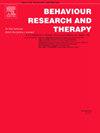心理意象在忧虑中的作用:来自幻像症的见解
IF 4.5
2区 心理学
Q1 PSYCHOLOGY, CLINICAL
引用次数: 0
摘要
担忧的特点是考虑到未来的负面结果,是焦虑的一个关键认知特征。有影响力的认知回避模型表明,担忧涉及负面潜在结果的视觉意象(心灵眼中的心理画面),随后由于其潜在的厌恶性质而试图避免这种意象(例如,用语言代替担忧)。在这里,我们通过测试有或没有幻像症的人来检验意象在焦虑中的作用——幻像症是一种严重的弱点或缺乏视觉意象。我们发现,尽管幻想症患者(n = 59)与想象症患者(n = 92)在自我报告的日常担忧和焦虑水平上没有什么不同,但他们拥有一些保护性特质:他们在灾难化访谈中不太可能发生灾难,自我报告受到担忧(在关注或成本上)的威胁较小,并且不太可能在认知上避免令人担忧的想法。此外,当他们的图像缺陷扩展到所有感官(感觉障碍)时,在停止担心的任务中,失忆症患者也能更好地根据命令停止担心。此外,我们考察了忧虑的现象学。我们发现,通过语言思维、视觉意象或任何形式的意象(如触觉、味觉、嗅觉等),幻想症患者更不容易担心。相反,幻觉者将他们的担忧体验为躯体症状,以及抽象的概念性思维。综上所述,我们的研究结果表明,虽然意象不是焦虑所必需的,但意象起着重要的作用,缺乏意象可以在一定程度上保护人们不受某些焦虑特征的影响。本文章由计算机程序翻译,如有差异,请以英文原文为准。
The role of mental imagery in worry: Insights from aphantasia
Worry is characterised by thinking about prospective negative future outcomes, and is a key cognitive feature of anxiety. The influential Cognitive Avoidance Model suggests that worry involves visual imagery (mental pictures in the mind's eye) of negative potential outcomes, followed by the attempt to avoid such imagery due to its potentially aversive nature (e.g., by worrying in words instead). Here, we examine the role of imagery in worry by testing people with and without aphantasia – a profound weakness or absence of visual imagery. We show that although aphantasics (n = 59) are no different than imagers (n = 92) in their self-reported levels of day-to-day worry and anxiety, they possess a number of protective qualities: they are less likely to catastrophise in a catastrophising interview, and self-report being less threatened by their worries (in concern or cost), and less likely to cognitively avoid worrisome thoughts. Additionally, when their imagery deficit extends to all senses (dysikonesia), aphantasics are also better able to stop-worrying on command in a stop-worry task. Additionally, we examined the phenomenology of worry. We show that aphantasics report being less likely to worry via verbal-linguistic thought, nor visual imagery, or imagery of any kind (e.g., tactile, taste, smell, etc). Instead, aphantasics experience their worries as somatic symptoms, and abstract conceptual thought. Together, our findings demonstrate that while imagery is not required for worry, imagery plays an influential role, and lacking imagery provides a level of protection against certain worry traits.
求助全文
通过发布文献求助,成功后即可免费获取论文全文。
去求助
来源期刊

Behaviour Research and Therapy
PSYCHOLOGY, CLINICAL-
CiteScore
7.50
自引率
7.30%
发文量
148
期刊介绍:
The major focus of Behaviour Research and Therapy is an experimental psychopathology approach to understanding emotional and behavioral disorders and their prevention and treatment, using cognitive, behavioral, and psychophysiological (including neural) methods and models. This includes laboratory-based experimental studies with healthy, at risk and subclinical individuals that inform clinical application as well as studies with clinically severe samples. The following types of submissions are encouraged: theoretical reviews of mechanisms that contribute to psychopathology and that offer new treatment targets; tests of novel, mechanistically focused psychological interventions, especially ones that include theory-driven or experimentally-derived predictors, moderators and mediators; and innovations in dissemination and implementation of evidence-based practices into clinical practice in psychology and associated fields, especially those that target underlying mechanisms or focus on novel approaches to treatment delivery. In addition to traditional psychological disorders, the scope of the journal includes behavioural medicine (e.g., chronic pain). The journal will not consider manuscripts dealing primarily with measurement, psychometric analyses, and personality assessment.
 求助内容:
求助内容: 应助结果提醒方式:
应助结果提醒方式:


